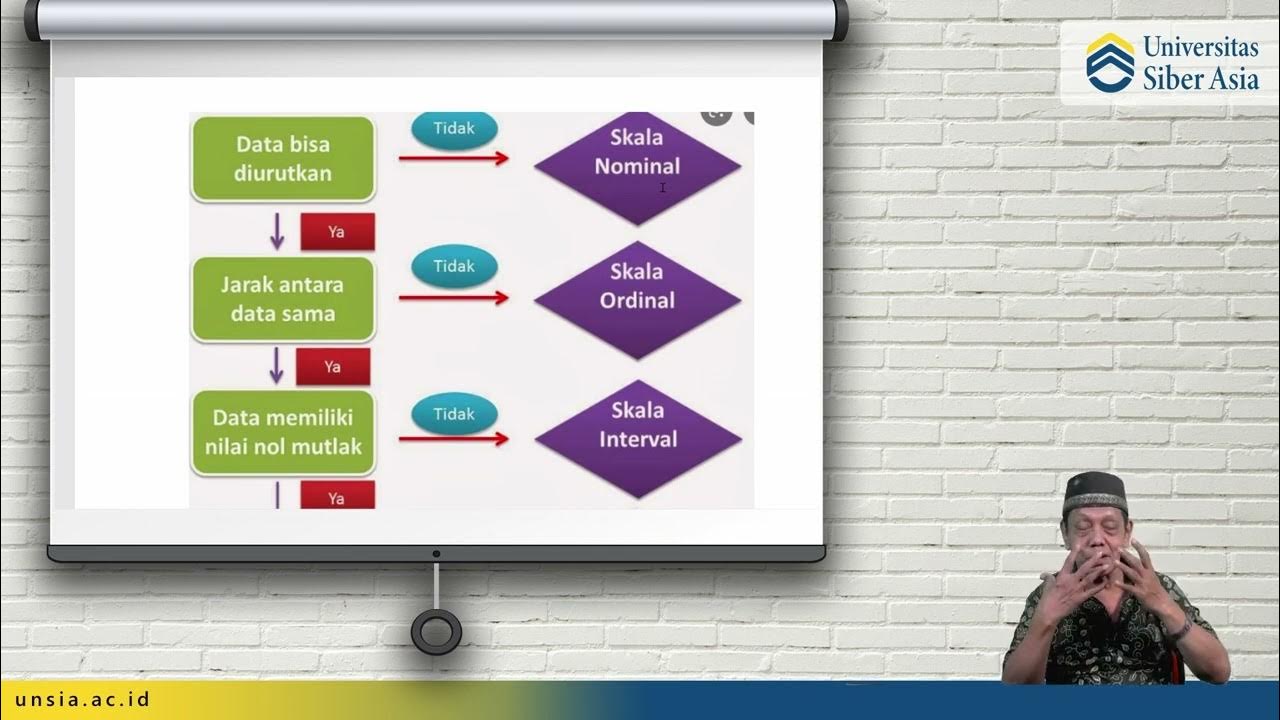[PART 2] STATISTIKA PENDIDIKAN: MENGENAL DATA
Summary
TLDRThis video discusses various scales of data used in research: nominal, ordinal, interval, and ratio. It explains each scale with real-life examples, such as education levels for ordinal data, income categories for ranking, wake-up times for interval data, and race times for ratio data. The video emphasizes the importance of understanding these scales for accurate data analysis, especially in quantitative research. It highlights how to properly categorize data based on its nature and provides a clear explanation of when and how to use each scale in different research scenarios.
Takeaways
- 😀 **Nominal Data** refers to categorical data that is used for classification without any inherent order (e.g., gender, types of fruit).
- 😀 **Ordinal Data** is used for categorization with a meaningful order, but the intervals between categories are not fixed (e.g., education level, ranking).
- 😀 **Interval Data** has both order and equal intervals, but lacks an absolute zero. An example is temperature in Celsius, where 0°C is not 'no temperature'.
- 😀 **Ratio Data** is similar to interval data, but with an absolute zero point, allowing for meaningful ratios (e.g., weight, speed, time).
- 😀 Ordinal data shows hierarchy but doesn’t measure the exact difference between categories, such as ranking education levels (SD, SMP, SMA, S1).
- 😀 Interval data allows for meaningful comparisons of differences between values (e.g., comparing the time intervals between different wake-up times), but cannot be used for meaningful ratios.
- 😀 Ratio data can be used for both differences and ratios, such as comparing the speed of runners in a 100-meter sprint, where 'twice as fast' has a clear meaning.
- 😀 The four scales of data (nominal, ordinal, interval, and ratio) should be clearly understood by researchers to choose the right method for analysis.
- 😀 Ordinal data can be used with scores to represent ranking or levels, such as assigning scores to education levels or income categories.
- 😀 To ensure accurate measurement in research, it's critical to choose the correct data scale based on the variables being studied, as this impacts analysis and results.
Q & A
What is the main difference between nominal and ordinal data?
-Nominal data is used for categorizing items without any order or ranking, while ordinal data involves ranking or ordering categories, but the intervals between the categories are not necessarily equal.
Can ordinal data be used to calculate precise differences between categories?
-No, ordinal data allows for ranking but does not provide equal intervals between the categories, so precise differences cannot be calculated.
How is interval data different from ordinal data?
-Interval data has ordered categories with equal distances between each point on the scale, whereas ordinal data only has ordered categories without equal intervals between them.
What is a key characteristic of ratio data?
-Ratio data has ordered categories with equal intervals and a true zero point, allowing for the calculation of ratios.
What is an example of nominal data provided in the transcript?
-An example of nominal data in the transcript is the classification of respondents based on their highest level of education, such as SD, SMP, SMA, or S1.
Why can't educational level be used to measure cognitive ability, as discussed in the transcript?
-Educational level is a measure of formal education but does not directly reflect cognitive ability, as individuals with higher education may not always demonstrate better cognitive or behavioral qualities in practical situations.
How is interval data applied in the example of wake-up times?
-In the wake-up time example, respondents are grouped based on the time they wake up (e.g., 4:00 AM, 5:00 AM, 6:00 AM), with equal intervals between times. However, there is no true zero point, as time can never truly start from zero.
What are the challenges in measuring abstract concepts with interval data?
-The challenge lies in developing instruments that can accurately capture abstract concepts, such as attitudes or perceptions, with a scale that assumes equal intervals between each category.
What example does the transcript provide for ratio data?
-The transcript provides an example of ratio data with the measurement of the time it takes to run 100 meters. The time is measured in seconds, and there is a true zero point, allowing for meaningful ratios between times.
What role do scales like nominal, ordinal, interval, and ratio play in quantitative research?
-These scales provide a foundation for analyzing and interpreting data in quantitative research. Choosing the correct scale is essential for applying appropriate statistical methods and drawing valid conclusions.
Outlines

This section is available to paid users only. Please upgrade to access this part.
Upgrade NowMindmap

This section is available to paid users only. Please upgrade to access this part.
Upgrade NowKeywords

This section is available to paid users only. Please upgrade to access this part.
Upgrade NowHighlights

This section is available to paid users only. Please upgrade to access this part.
Upgrade NowTranscripts

This section is available to paid users only. Please upgrade to access this part.
Upgrade NowBrowse More Related Video

Scales of Measurement - Nominal, Ordinal, Interval, & Ratio Scale Data

STATPROB Levels or Scales of Measurement

Pertemuan 5 - Statistik - Prof. DR. H. Budi Santoso, MSc, APU

02 Klasifikasi data statistika

Scales of Measurement: Nominal, Ordinal, Interval and Ratio Scale

Levels of measurement - Research Methods [A-Level Psychology]
5.0 / 5 (0 votes)